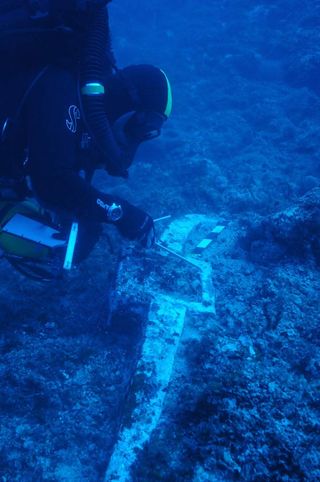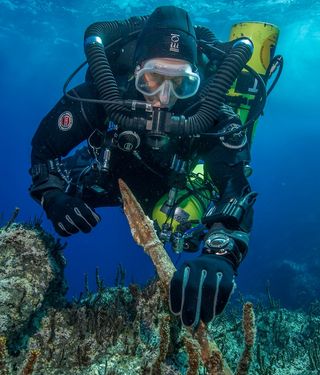Ancient Greek 'Antikythera' Shipwreck Still Holds Secrets

An ancient shipwreck doesn't give up all its secrets at once. Greek authorities have approved a five-year extension for an international team of explorers to continue probing the remains of a 2,085-year-old shipwreck known for holding what is considered the world's oldest computer.
The ship, which likely sank between 70 B.C. and 60 B.C. as it trekked west from Asia Minor to Rome, holds plenty of treasure: During the first phase of the project "Return to Antikythera," which ended in October 2014, undersea explorers found tableware, a lead anchor, a giant bronze spear that may have been part of a statue of a warrior or the goddess Athena, and other artifacts.
With this newly approved extension, researchers will focus on known hotspots for pottery and metal objects; the team hopes to complete a detailed map of the wreck site and excavate treasure and artifacts from the ship. [See Photos of the Ancient Antikythera Shipwreck and Treasure]
In preparation for this second phase, slated to begin at the end of summer, researchers sent an autonomous underwater vehicle (AUV) to digitally survey the shipwreck from June 9 to 19. On Saturday, June 13, the AUV and its metal detector located small pieces of copper-, bronze-, lead- and iron-bearing materials. The following Monday, the AUV got up close and personal with the artifacts, taking pictures and collecting spatial data, including where the artifacts are in relation to each other. Over the next five years, beginning at the end of this summer, the researchers will excavate pieces of the Antikythera shipwreck.
Luxury goods
The previous expedition, which began in 2012, was a collaboration between the Hellenic Ephorate of Underwater Antiquities in Greece and Woods Hole Oceanographic Institution (WHOI) in Woods Hole, Massachusetts. The two entities will continue to work together on the second phase, with aid from WHOI's diving robotic Exosuit, which the researchers describe as "Iron Man for underwater science."

The 2012-2014 expedition resulted in a 3D model of the seafloor with photos of the wreckage. Researchers also added metal-rich locations to the map data. The new data went into the geoinformation system (GIS) database, which includes all known geographic data for the region since 1900.
Sign up for the Live Science daily newsletter now
Get the world’s most fascinating discoveries delivered straight to your inbox.
Researchers found two sites that are separated by 328 feet (100 meters), which means either the ship broke into two sections after smashing into the rock coast, or there were two ships that simultaneously met their doom.
"The evidence shows this is the largest ancient shipwreck ever discovered," Brendan Foley, a marine archaeologist from WHOI, said in a previous statement. "It's the Titanic of the ancient world."
The expedition thus far has yielded a range of artifacts. "The shipwreck of Antikythera offers a glimpse into the diversity of its cargo," Aggeliki Simosi, the director of the Hellenic Ephorate of Underwater Antiquities, said in a statement. She added that the ship's discovery confirmed the existence of a luxury-goods trade route along eastern Mediterranean countries. "The ship that sank at Antikythera was not merely a cargo ship. It was essentially a floating museum," she said.
Cousteau expedition
The Antikythera shipwreck was discovered by a couple of sponge fishermen from the Greek island Symi over a century ago off the coast of Antikythera, a small Greek island with a population of 45. The dive of the fishermen revealed pieces from the wreck — he brought to the surface an arm from a bronze statue that had settled between 138 and 164 feet (42 and 50 m) below the surface.
With assistance from the Greek Education Ministry and Royal Hellenic Navy, the sponge divers recovered various statues, including those of Ulysses, Diomedes and his horses, Ermes, Apollo, and many others. Upon analyzing the artifacts once they were in the museum, then-Minister of Education Spyridon Stais discovered what is now known as the Antikythera mechanism, which is thought to be the world's oldest known computer.
In 1953, Captain Jacques Cousteau, the famed French naval officer and underwater explorer, along with Massachusetts Institute of Technology engineering professor Harold "Doc" Edgerton, sailed to Antikythera and discovered another shipwreck marked by a lead anchor and amphoras (two-handled vessels for holding a liquid like wine or oil) sticking out of the sand.
Cousteau returned to Antikythera in 1976 for a television series about the history and attractions of Greece. Over the course of 27 days, Cousteau and his team recovered hundreds of objects, including ceramic vessels, parts of marble statues, bronze statuettes, bronze coins, gold jewelry, gemstones, glassware and human skeletal remains.
Elizabeth Goldbaum is on Twitter. Follow Live Science @livescience, Facebook & Google+. Original article on Live Science.

Most Popular


